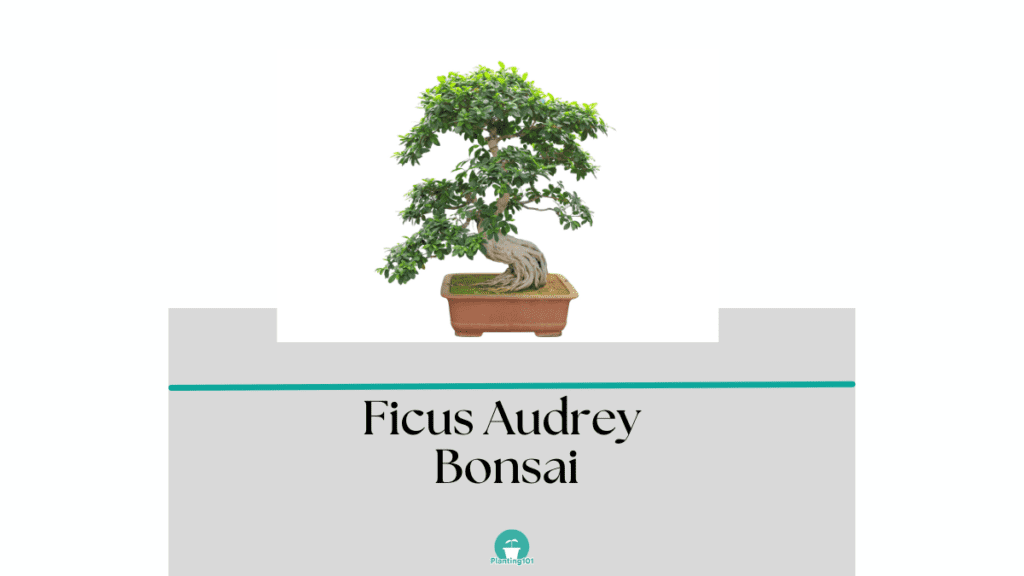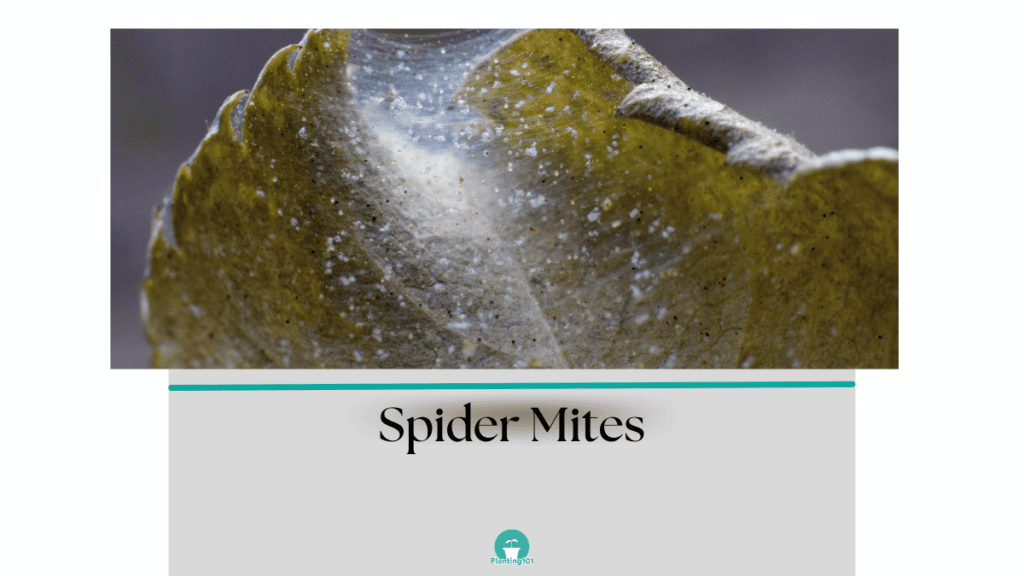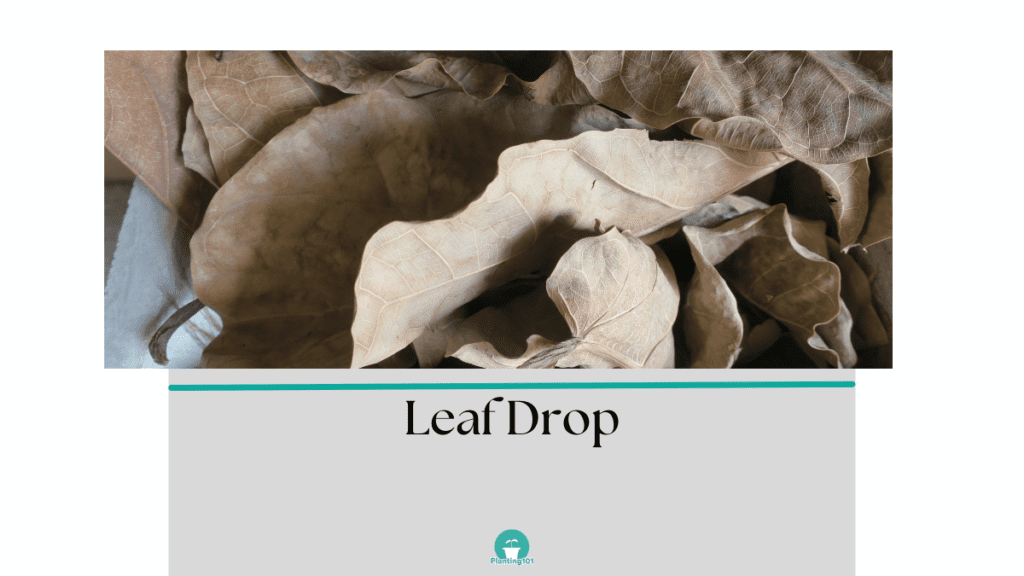Ficus Audrey (Ficus benghalensis) is the less fussier version of the Fiddle-Leaf Fig (Ficus lyrata). Similar to Fiddle-Leaf Fig, it is a bold, statement plant but without the high maintenance. If you are looking for a houseplant that looks like a little tree, then Ficus Audrey is a good choice for you. Ficus Audrey is also popular as a bonsai because it looks a miniature tree.
Compared to the Fiddle-Leaf Fig, Ficus Audrey is easier to care for because it is not as sensitive to temperature fluctuations and can better tolerate inconsistent watering. Here is a guide on how to take care of your Ficus Audrey.
Ficus Audrey Infographic

Ficus Audrey Characteristics
| Name | Ficus Audrey |
| Scientific Name | Ficus benghalensis |
| Light | Bright Indirect Light |
| Daytime Temperature | 70 to 80 F (21-26C) |
| Night Time Temperature | 60 to 70 F (15-21C) |
| Water | Medium Water |
| Humidity | High Humidity |
| Potting | Well-draining, organic, all-purpose potting soil |
| Fertilizer | Once every month but not in the Fall or Winter |
What are Other Names of the Ficus Audrey Plant?
Ficus Audrey is also called the Banyan Tree.
Do Ficus Audrey Plants Prefer Sun or Shade?
Ficus Audrey plants will thrive in a bright area without direct sunlight (you need to filter the light). It is not happy in shade.
Placement of Your Ficus Audrey Plant
East Facing Window
If you have an East facing window, your Ficus Audrey can tolerate a few hours of direct morning sun.
West Facing Window
If you place it in front of a West facing window, the direct sun from the afternoon sun is too intense for your Ficus Audrey. You will need to filter the light with sheer blinds or sheer curtains.
South Facing Window
If you place your Ficus Audrey in front of a South facing window, the direct sun all day is also too intense so you will also need to filter the light.
Your Ficus Audrey needs direct filtered sunlight, if you place it in an area that is mostly shade then it will not be happy and will not grow as well.

How Do I Know When to Water Your Ficus Audrey?
Water your Ficus Audrey when the soil feels dry. The best way to tell when it’s time to water is by sticking your finger into the soil 1 inch deep. If the soil feels dry, then it’s time to water your Ficus Audrey.
The frequency of watering will be dependent on the type of pot you have your Ficus Audrey in. Unglazed pots like terracotta are porous and will dry up more quickly than if you have your Ficus Audrey planted in plastic, metal or glazed ceramic pots. These pots don’t breathe so will retain moisture much longer.
The environment will also affect how often you water your Ficus Audrey. Hot summer days will require more watering (even if your Ficus Audrey is indoors) while cold, winter days will require less watering.
What Type of Water Should You Use When Watering Your Ficus Audrey?
Ficus Audrey can be watered with tap water but be mindful of the water temperature that you are using to water your Ficus Audrey. Don’t use straight cold water from the tap to water your Ficus Audrey.
Ficus Audrey prefers cool water that is not hot and not cold. When you turn on the cold water from the faucet add a little bit of warm water. You can also get to this ideal temperature by filling a watering can or pitcher with water and leaving it out overnight until the water is at room temperature.
How Do You Make Sure There is Proper Drainage for Your Ficus Audrey?
Ficus Audrey needs proper drainage otherwise it might suffer from stem rot. To ensure proper drainage, make sure the pot has drainage holes at the bottom. After watering your plant, don’t let it sit in the puddle of water that has accumulated in the saucer. Empty out the water from the saucer.
What Type of Potting Mix is Best for Your Ficus Audrey?
Ficus Audrey needs a well-draining, organic potting mix. You can buy premixed potting soil with organic fertilizers and beneficial microbes like mycorrhizal fungi.
It’s best to buy organic soil mixtures because non-organic soil mixtures often contain a higher concentration of fertilizer which can burn the roots of your plant. Non-organic soil mixtures are not generally suitable for houseplants.
Do You need to Fertilize Your Ficus Audrey Plant?
Ficus Audrey will benefit from a once a month application of fertilizer. Apply fertilizer at half strength when it’s actively growing. Don’t feed in the Fall and Winter months when it’s dormant and not growing.
What Fertilizer Should You Use for Your Ficus Audrey?
Use organic fertilizers with a higher ratio of nitrogen content.
How Do You Know When To Repot Your Ficus Audrey?
You will need to repot your Ficus Audrey every year. Buy a larger pot, around 4 inches larger in diameter than the current pot. Make sure you buy a pot that has drainage holes at the bottom so water doesn’t accumulate and cause root rot and stem rot.
Your Ficus Audrey can grow really big, stop repotting once you have reached optimal size. Repot Ficus Audrey in a heavy pot so it doesn’t topple over. When repotting Ficus Audrey, wear gloves because Ficus Audrey is toxic to humans.
How Big Do Ficus Audrey Plants Get?
Ficus Audrey are large houseplants that can grow to 8 to 10 feet tall. You will need a heavy pot for your Ficus Audrey so it doesn’t topple over.
What are Common Problems that Affects Ficus Audrey Plants?
The common problems that affect Ficus Audrey are spider mites, leaf drop and leaf spot fungus.
Why are There Yellow and Brown Spots on Your Ficus Audrey Leaves and There are Webbing on Leaves and Stems?
These are signs of spider mites attacking your Ficus Audrey. It starts with yellow and brown spots on leaves and then eventually the entire leaf can even turn yellow and fall off the plant. You will also start to see spider web-like webbing covering the leaves and stems. These are telltale signs of spider mite infestation.
To treat spider mites on Ficus Audrey, you can spray off the leaves with water from a garden hose. The force will cause the little spider mites to wash off the leaves. You can also wash mites off with soapy water or rubbing alcohol. There are also horticultural oils and insecticidal soaps that you can use to kill off spider mites.
Check out our article on how to make your own homemade pesticides using baby shampoo: How to Make Horticultural Oil and How to Make Insecticidal Soap

Why are Your Ficus Audrey Leaves Dropping?
When you see your Ficus Audrey leaves dropping, that is a sign that something is wrong. It’s normal if one or two old leaves drop from Ficus Audrey but if a lot of leaves fall off all at once that is a sure sign that something is wrong.
It’s possible your Ficus Audrey leaves are dropping because it’s been overwatered. Moving your Ficus Audrey to a new location where it is not happy can also cause the leaves of your Ficus Audrey to drop. Your Ficus Audrey can also drop leaves if it’s too cold.
You need to do a little bit of digging around. Did you overwater your Ficus Audrey? What is the daytime and nighttime temperature of the room, is it suitable for your Ficus Audrey? You can resolve the leaves dropping problem, once you pinpoint what is causing the leaves to drop from your Ficus Audrey.

Why are there Black or Brown Spots on the Leaves of Your Ficus Audrey?
If you see roundish black and brown spots on the leaves of your Ficus Audrey this could be a sign of leaf spot fungus infection. Leaf spot fungus is contagious because the fungus spores can travel in the air to infect other plants in the room. When you see these black and brown spots on the leaves of your Ficus Audrey, immediately cut off the infected leaves and throw it away.
You can also spray your Ficus Audrey with a homemade baking soda spray to prevent new infections. To make the baking soda spray, simply mix 1 teaspoon baking soda to 1 quart water and put it in a spray bottle. Don’t overspray since it can get in the soil. The key is to remove the infected leaves and that should hopefully stop the spread.

You May Also Be Interested In:
How to Take Care of Haworthia (infograph)

